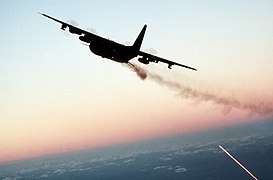Saturation fire
Saturation fire is an intense level of artillery, autocannon, or machine gun fire which is designed to fill an enemy position with artillery shells or machine gun fire.
Artillery
.jpg)
Saturation fire might be used to bombard an area just before an offensive. Another kind of intensity used to bombard an area during an offensive is a barrage. Saturation fire is used most of the time before an offensive to bombard an enemy area and lower enemy morale and ability to fight.
In the Battle of the Bulge, German troops used Werfer rocket batteries to do saturation fire on Allied positions, particularly prior to an attack.[1] Benjamin Colby claims that the U.S. did saturation fire-bombing of Dresden in 1945.[2]
During the Vietnam War, the US used saturation fire against the Vietnamese forces. In one example in 1972, US air forces did saturation fire around a bunker where seven US advisers alongside a number of South Vietnamese ARVN soldiers were surrounded by NVA forces which had been subjecting the bunker to a withering attack for days.[3]
Machine gun
Automatic weapons, especially belt-fed, crew-served machine guns, can be used to deliver a high volume of fire at enemy positions. A history of German military doctrine states that "...laying down saturation fire [with small arms] will keep your enemy's head down while allowing you to get on with the approach to the objective.[4] During the Vietnam War, AC-130 aircraft incorporated side-firing 20 mm Gatling-style cannons which allowed them to provide area-saturation fire as the aircraft circled over a target. Another use of saturation fire in the Vietnam War was with "guntrucks" in convoys. These "21⁄2-ton cargo vehicles" with "two M-60 machine gunners" would "... provide a rapid, retaliatory saturation fire within the critical first 3 minutes of an enemy attack [e.g., an ambush of the convoy]". [5]

The use of automatic weapons for saturation fire has been criticized by a major US gun maker. The President of Armalite Inc. states that using an automatic rifle such as his company's AR-15 for saturation fire can waste ammunition, a situation which is particularly problematic in cases where soldiers have to carry their own ammunition. He argues that using carefully aimed semiautomatic fire can be more effective than sweeping enemy positions with random, full-automatic fire.[6]
US soldier Paul Howe supports this view in his statement that "volume [of full-automatic fire] in the wrong place is useless".[7] An author argues that the widespread use of automatic rifles such as the M-16 by the US army in Vietnam, Cambodia, and Laos, along with the "... concept of saturation fire and general abandonment of the principles of individual marksmanship and weapon performance" led to military failures; he argues that "...there must be a balance between accuracy and firepower in the general application".[8]
References
- Battle of the Bulge: Hitler's Ardennes Offensive, 1944–1945. Danny S. Parker - 2004
- Benjamin Colby. Twas a Famous Victory. Deception and Propaganda in the War With Germany. Arlington House; First edition. edition (January 1, 1974)
- "Can you hold out for just eight more minutes" LIFE 21 Apr 1972
- Waffen-SS Soldier 1940-45. Bruce Quarrie, Jeffrey Burn. Osprey Publishing, 1993. p.26
- Guntrucks of Ambush Alley. Reproduced from the Army Logistician, July–August 1986. Available online at: http://grambo.us/atav/gunstory.htm Accessed on December 5, 2010
- Gun Digest Book of the AR-15, Volume 2. Patrick Sweeney. Gun Digest Books, 2007. p.10
- Gun Digest Book of the AR-15, Volume 2. Patrick Sweeney. Gun Digest Books, 2007. p.10
- The M1 Garand Rifle. Available online at:http://www.pattonhq.com/garand.html Accessed on December 5, 2010.